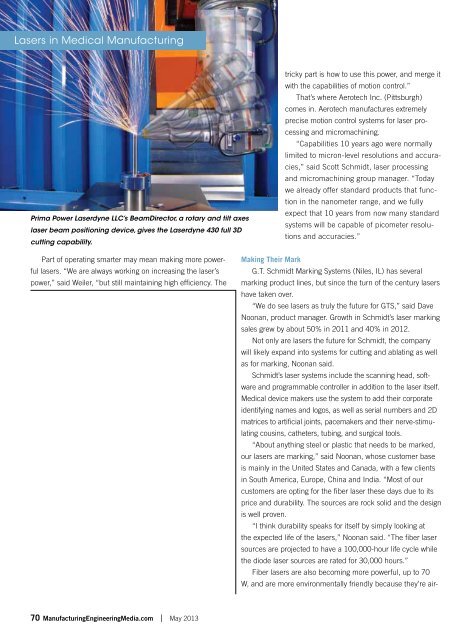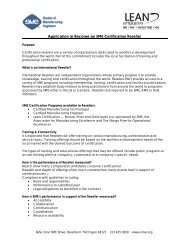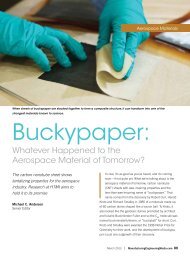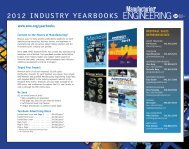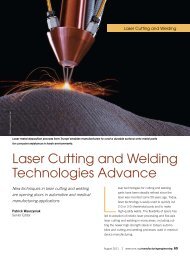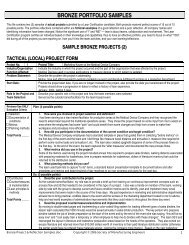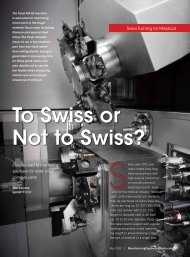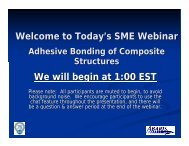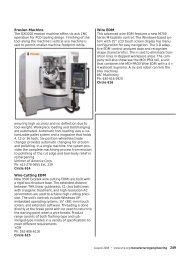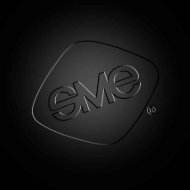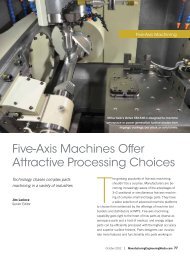You also want an ePaper? Increase the reach of your titles
YUMPU automatically turns print PDFs into web optimized ePapers that Google loves.
Lasers in Medical Manufacturing<br />
Prima Power Laserdyne LLC’s BeamDirector, a rotary and tilt axes<br />
laser beam positioning device, gives the Laserdyne 430 full 3D<br />
cutting capability.<br />
tricky part is how to use this power, and merge it<br />
with the capabilities of motion control.”<br />
That’s w<strong>here</strong> Aerotech Inc. (Pittsburgh)<br />
comes in. Aerotech manufactures extremely<br />
precise motion control systems <strong>for</strong> laser processing<br />
and micromachining.<br />
“Capabilities 10 years ago were normally<br />
limited to micron-level resolutions and accuracies,”<br />
said Scott Schmidt, laser processing<br />
and micromachining group manager. “Today<br />
we already offer standard products that function<br />
in the nanometer range, and we fully<br />
expect that 10 years from now many standard<br />
systems will be capable of picometer resolutions<br />
and accuracies.”<br />
Part of operating smarter may mean making more powerful<br />
lasers. “We are always working on increasing the laser’s<br />
power,” said Weiler, “but still maintaining high efficiency. The<br />
Making Their Mark<br />
G.T. Schmidt Marking Systems (Niles, IL) has several<br />
marking product lines, but since the turn of the century lasers<br />
have taken over.<br />
“We do see lasers as truly the future <strong>for</strong> GTS,” said Dave<br />
Noonan, product manager. Growth in Schmidt’s laser marking<br />
sales grew by about 50% in 2011 and 40% in 2012.<br />
Not only are lasers the future <strong>for</strong> Schmidt, the company<br />
will likely expand into systems <strong>for</strong> cutting and ablating as well<br />
as <strong>for</strong> marking, Noonan said.<br />
Schmidt’s laser systems include the scanning head, software<br />
and programmable controller in addition to the laser itself.<br />
Medical device makers use the system to add their corporate<br />
identifying names and logos, as well as serial numbers and 2D<br />
matrices to artificial joints, pacemakers and their nerve-stimulating<br />
cousins, catheters, tubing, and surgical tools.<br />
“About anything steel or plastic that needs to be marked,<br />
our lasers are marking,” said Noonan, whose customer base<br />
is mainly in the United States and Canada, with a few clients<br />
in South America, Europe, China and India. “Most of our<br />
customers are opting <strong>for</strong> the fiber laser these days due to its<br />
price and durability. The sources are rock solid and the design<br />
is well proven.<br />
“I think durability speaks <strong>for</strong> itself by simply looking at<br />
the expected life of the lasers,” Noonan said. “The fiber laser<br />
sources are projected to have a 100,000-hour life cycle while<br />
the diode laser sources are rated <strong>for</strong> 30,000 hours.”<br />
Fiber lasers are also becoming more powerful, up to 70<br />
W, and are more environmentally friendly because they’re air-<br />
70 ManufacturingEngineeringMedia.com | May 2013


